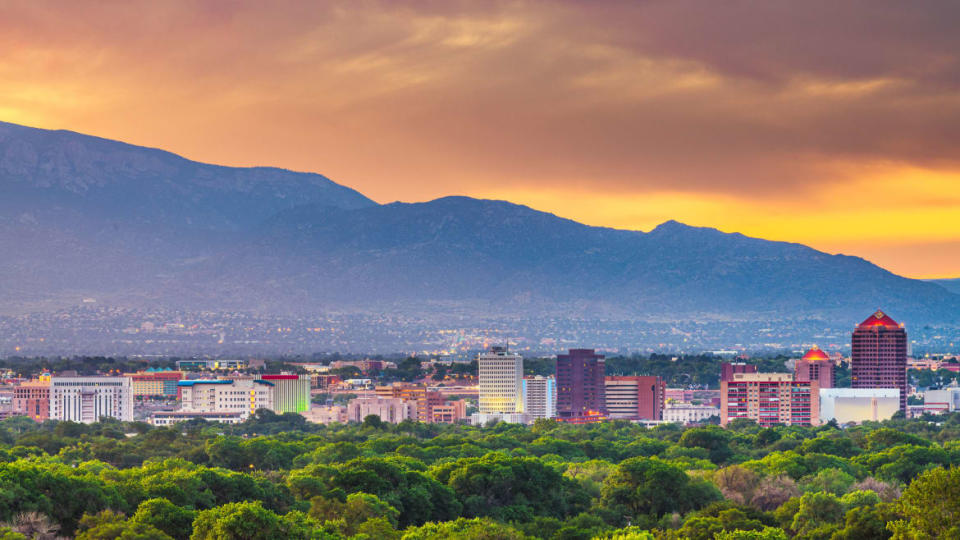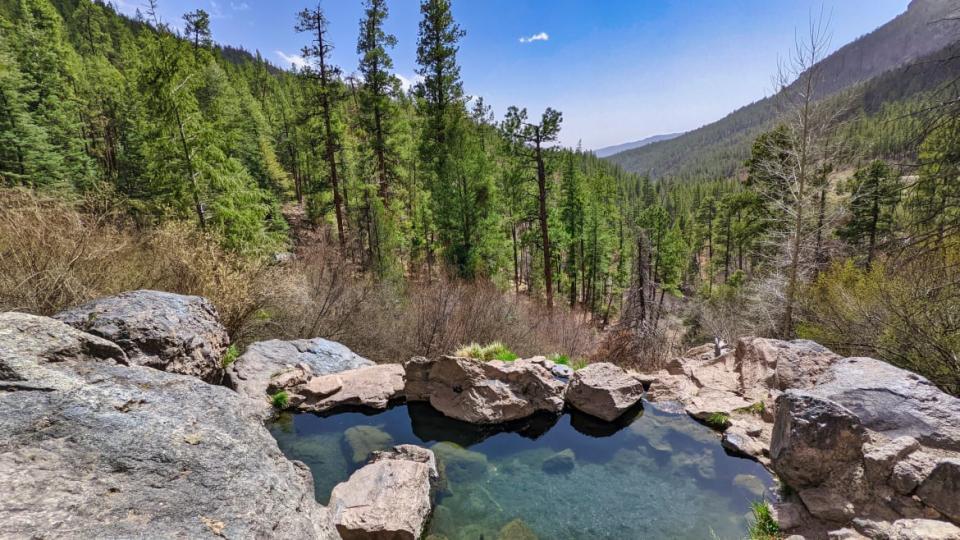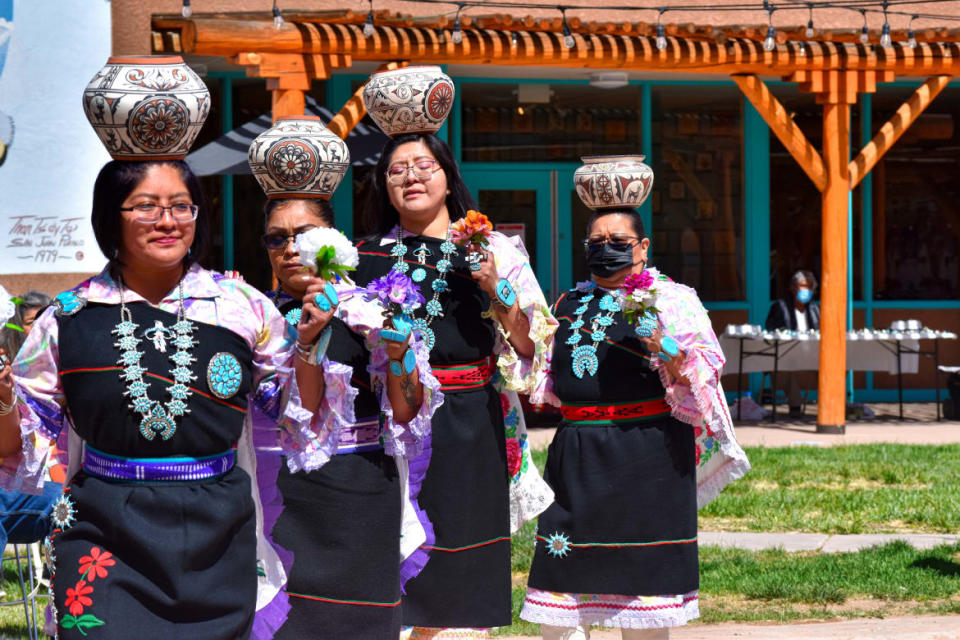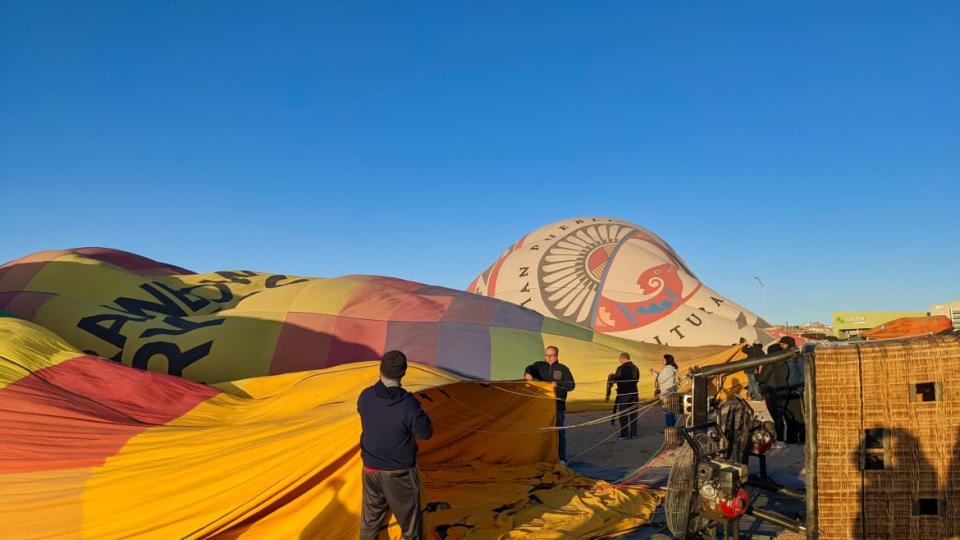For This Overlooked Southwest City, the Mountains Are Its Skyline

This is the latest in our twice-a-month series on underrated destinations, It’s Still a Big World.
Another tree came crashing down.
It fell on a trail leading to Spence Hot Springs, a natural spring north of the greater Albuquerque area, which I was visiting at the invitation of its tourism office. It was also a sign of more to come, as the six days were full of surprises.
My drive up on day one started in a desert dust storm with 75 mph gusts that blocked out the mountain views in the distance. I knocked sand out of everything for days. Once you’re at Spence, it is hard to ignore its wonderfully wide view of the mountains. So even with some falling trees, I decided I needed to enjoy a quick soak in its waters.
But there was more.
“There’s a forest fire just about 7 miles away,” a woman told me, pointing east as she was leaving. As it turned out, these rare epic winds also managed to kick up what is now called the Cerro Pelado Fire.
Another man made his way up to the spring, dropped trou, and jumped in. “You might want to keep track of your clothes,” I told him, letting him know about the fire.

Tree No. 3 fell. “That’s my final call,” I said, getting up to leave and head south to the small town of Jemez Springs. (While hitting the trail back to parking: tree No. 4.)
Jemez Springs is a small, charming town just north of Albuquerque. It’s known for its many natural springs, like Jemez Hot Springs, a collection of outdoor therapeutic mineral water pools with different temperatures originating from the Valles Caldera National Preserve. The pools are connected to lodging, with seating, and a meditative setting. There are also the stone ruins of a 500-year-old Pueblo village in the area, and interesting geological features, like the Soda Dam, a 7,000-year-old mineral deposit build-up.
I stopped in town at Los Ojos Restaurant & Saloon for lunch. It felt like an Old West saloon, complete with the high winds regularly blowing open the front door. It also has a fortifying menu, including a wonderful beer-battered zucchini.
After arriving back in Albuquerque, I checked into Hotel Andaluz for a night. Built in 1939 as a Hilton Hotel, it is on the National Register of Historic Places. The hotel was influenced by the Moorish architecture of Spain’s Andalusia province, which shows up from the details of its lobby’s art to the pointed horseshoe arches in their cozy rooms. Hotel Andaluz has also earned LEED gold certification—a program recognized as the standard measure for green, sustainable buildings.
Before I arrived in Albuquerque—New Mexico’s largest city—what I knew about it was what most might know—it is famous for hot air balloons. Every October they have a Balloon Fiesta, where 500 balloons fill the sky. Whenever I mentioned I was heading to Albuquerque, people would mention the balloons. The other thing that people might know, if they read the news, is that the city has struggled with its high crime rate and policing, leading to years of Department of Justice oversight of its police force.
As with any city, though, Albuquerque is more than its headlines. The next few days introduced me to an area of central New Mexico that is packed with culture, experiences, and surprises.
Day One: Dust storm. Soak in a hot spring. Forest fire. Check.
The next day, I checked out and headed to breakfast at the Indian Pueblo Cultural Center (IPCC). There are 19 Pueblo tribes in New Mexico, and the center, with its museum and tables for artists to sell their work, is a fantastic place to learn about those nations and their history. That Puebloan story informs every part of Albuquerque, from its architecture to its food. The IPCC’s Indian Pueblo Kitchen, which is centered on Indigenous cuisine, is a good place to start for food.
While I was there, I was able to watch the Zuni Olla Maidens perform a cultural pottery dance—a colorful dance which requires balancing a decorative pot on the head. (I began counting how often I would have dropped those pots.)

From there I headed to the towering Sandia Mountains for a short hike on the Piedra Lisa trail.
The Sandia Mountains, which rise to the east of the Rio Grande are the background to Albuquerque. No trip to Albuquerque is complete without a little time on the mountains. Sandia is Spanish for “watermelon,” which references the pink hues that shine from the granite in the mountains at sunset. You can’t drive anywhere in the area without these beautiful, sky piercing mountains looking over you.
The Piedra Lisa trail winds up the mountains and can be easily kept to within a few miles round trip, depending on your skill. It is sometimes a rocky trail and provides some astonishing views of the mountain and the valley below it. The trails along the mountains, while maintained, are not always clearly marked, so it is worth paying attention. There is wildlife—black bears, bobcats, coyotes, rattlesnakes—but if they saw me, I didn’t see them. I did, however, almost step on a striped scorpion, which stings but isn’t lethal. (We quietly acknowledged each other and then moved on.)
I followed this up with what is a requirement for any visitor to Albuquerque—riding the Tramway up the Sandia Mountains just a couple miles down the road
Riding up to an elevation of 10,300 feet, the view from the Tramway car ($29 roundtrip for an adult; $19 for children) is like sitting on top of the world.
And at the top of the world, the restaurant, TEN 3, has both fine and casual dining. Get reservations for fine dining in the evening to enjoy a stunning sunset. Their beer-battered squash blossoms, with goat cheese, red chili oil, and roasted poblano puree is hard to forget, as is the Chilean sea bass with sweet pea risotto and shaved black truffles.
That night, I checked into Hotel Chaco, a boutique hotel located in Old Town and the Sawmill neighborhood (classic king starting at $349+). Hotel Chaco is part of the Heritage Hotels & Resorts collection, “a New Mexico-based, minority-owned company,” with the goal of telling the story of New Mexico through “culturally distinct” hotels. The stone facade mimics its surrounding Southwestern climate, and is inspired by the ancient ruins of the nearby Puebloan, Chaco Canyon and its five stories of Pueblo Bonito. The hotel commissioned artwork from Native American artists, whose art is also available in their Gallery Hózhó on the first floor.
Their rooftop restaurant, Level 5, offers high-end dining with an unimpaired view of the Sandia Mountains. Their menu is divided by land and water. (The airline chicken breast—corn flan, zucchini, mushrooms, pancetta, and chimayo chile—was moist and perfect for a chilly night.) For breakfast, see their sister property Sawmill Market across the street. A former lumberyard building, it is now an artisanal food hall. (If you’re looking for waffles, check out XO Waffle’s chicken and waffles with spicy maple syrup and green onions.)
Day Two: Watch a pottery dance. Conquer a mountain. Say hi to a scorpion. Eat a flower at the top of the world. Check.
The next day I was up early meeting the Rainbow Ryders for a bucket-lister: a hot air balloon ride.

My ride consisted of only about a half-dozen balloons, but rising up over the Rio Grande Valley in a wicker basket is no less impressive and the view no less endless. It is quiet up there—and chilly. Pilots can’t control the direction of their flight, so they use a combination of moves, skating closer to the ground, and then rising higher, to get the right currents to take them to a good landing spot. When rides are done, they celebrate with a glass of bubbly—even if it was still before breakfast.
Moments of being closer to the ground can have its benefits, like watching coyotes running below us. It also helps when (in a rare moment) one of the vent ropes catches the pilot’s smaller radio that was clipped to his belt, tossing it out of the basket. We were able to drop to the ground, and a fellow rider hopped off in a pinch and followed the voice of the pilot to find the radio not far in the distance.
After a lunch at Duran’s, a local staple that combines a pharmacy with a diner, I made a quick visit to Petroglyph National Monument. Petroglyph is essentially an ancient art gallery with cultural and religious expressions etched in stone roughly 400 to 700 years ago. If you’re short on time, visit the Boca Negra Canyon section, which takes about an hour and a half to hike, with plenty of petroglyphs to be spotted around each corner. (Parking is $2.00 or free with a National Park pass.)
Afterwards, I hopped over to Electric Playhouse, a cool artsy space which has immersive games and hosts immersive events and musical performances. During the day, those immersive games allow kids to have fun while their parents watch with drinks in hand. (I’m not going to brag, but I managed to crash a little girl’s birthday party and get a high score on one of those games.)
I followed that up with visiting historic Old Town and its beautiful adobe, Pueblo-Spanish style architecture. Once Albuquerque’s center after its founding in 1706, it is full of shops and galleries, and the fantastic tasting room of Noisy Water Winery & Cellars. (Be sure to try their Rojo Caliente, a red chili wine that is fortified with brandy.)
Day Three: Soaring the skies in a wicker basket under a lit flame. Sea ancient art. Crash a kid’s birthday celebration. Check.
Riding horseback has also become a thing for me—as in, whenever I travel I look for a chance for a guided tour on a trail horse. In Albuquerque, I found it at The Stables at Tamaya, a horse rehab non-profit at The Hyatt Tamaya Resort & Spa. This out-of-the way stable trains horses, essentially giving them a job, which in many cases means hanging out with middle-aged guys like me.
Me and my horse, Joe, rode to the Rio Grande under the open sky and over a dry dusty landscape that on more than one occasion made both he and I sneeze. (Based on my growing collection of allergies, I’m convinced that my cowboy name would be Sneezy.)
It’s hard to not love being on a horse. It’s even harder to complain about a place that gives them ongoing life.
After spending time in the sun, I stopped in at the trendy Bow & Arrow Brewing Co. Owners Shyla Sheppard and Missy Begay are the first Native women to own a brewery in the United States. (I can't confirm or deny it, but I might have planned my trip to the city, just so I could taste their beers.)
Sheppard was raised on the Fort Berthold Reservation in North Dakota, and is a member of the Three Affiliated Tribes (Mandan, Hidatsa & Arikara Nation), while Begay was born in Albuquerque and raised on the Navajo (Diné) Nation. In college, the couple bonded over their love of craft beer and the science behind it.
Being the first Native women to own a brewery, however, wasn’t their original intention.
“I feel like we're just living life and making beer, using the things that we like,” Begay told me while I explored a flight, “and then all of a sudden, I feel like there’s more of a focus on us, because people are becoming more socially aware of how identity or culture can influence beer.”
Bow & Arrow makes traditional beers, but they use local ingredients that pick up on Native history, like replacing malt with roasted blue corn in their Denim Tux Pilsner. Their Foederland Foeder-Aged Farmhouse Ale, which was my favorite, is fermented for 14 months and uses regionally sourced ingredients, is well-balanced and has complicated fruity notes that surprise you, including peaches and apricots. My biggest regret is that I can’t get it at home.
Day Four: Ride a horse named Joe in a desert. Have a beer made with Native ingredients. Check.
As the trip was coming to a close, the question became, how do you finish it off? On my penultimate day, I road-tripped the Turquoise Trail National Scenic Byway along Route 14 to my final destination, Ojo Santa Fe Spa Resort.
But first, that Turquoise Trail.
The 50-mile trail is the most-scenic, history filled route between Albuquerque and the southern edge of Santa Fe, with stops along the way that capture the area’s background, like the Tijeras Pueblo Archaeological Site—an over-700-year-old ancestral Pueblo village—which has a self-guided interpretive trail and a museum. The museum is not always open, but the short trail is worth the visit. A stop in Madrid finds an old mining town that has evolved into an artist’s community, and the town of Cerrillos feels like stepping back into the old west, which is why it also happens to be a location for filming parts of Young Guns.
At the north end of the trail, I finished my trip off with a night as a guest of Ojo Sante Fe Spa Resort. I stayed in their adobe Casitas ($425+), which had a walled, private patio and a fountain just outside my patio door. The rooms are bright and open and the king beds are comfortable. They also have trails around the property for hikers and nature walks, within easy access of the rooms.
Before a massage, I soaked in their triple-filtered thermal soak pools, which are filled from their natural aquifer—they also have a saltwater swimming pool. Their thermal soak pooks have cabanas and hammocks to kick back and relax. I followed that up with a 50 minute therapeutic massage.
That night, I had dinner at their restaurant, Blue Heron. I started with their Poblano Fries (roasted poblanos, potato starch, and agave sweet chile gastric), and followed that up with their Duroc Pork Tomahawk Chop (green chile cheddar grits, baby carrots and asparagus, and caramelized peach sauce), which is a bone-in pork chop, with the bone exposed (like a handle), and taken from an extremely tender cut of meat. You'll never want a regular pork chop again.
Day 5: Scenic historic drive to an oasis. Soak. Massage. Incredible meal. Check.
The next day, I did the anti-climatic thing: I drove back to the airport.
Road-trips like these allow for an exploration of a city and its many sides. Albuquerque is an area that goes beyond its skyline, which itself is interesting. The city’s tallest building is 22 stories (Albuquerque Plaza). I was told by my hot air balloon pilot that they’ve limited the height of buildings for a reason.
“The mountains are our skyscrapers,” he said.
And that strikes me as wonderful, not only because I prefer not having the presence of mountains shrouded by buildings, but also because it serves as a reminder that the best parts of Albuquerque are not just what are found downtown—though that is great. The best part of Albuquerque, as it is with many places, is often what you find exploring in its corners and limits.
For Albuquerque, that means a place rich in Puebloan history (one literally etched in stone), wonderful food, a watermelon sky, and land fit for adventure.
Get the Daily Beast's biggest scoops and scandals delivered right to your inbox. Sign up now.
Stay informed and gain unlimited access to the Daily Beast's unmatched reporting. Subscribe now.

 Yahoo Finance
Yahoo Finance 